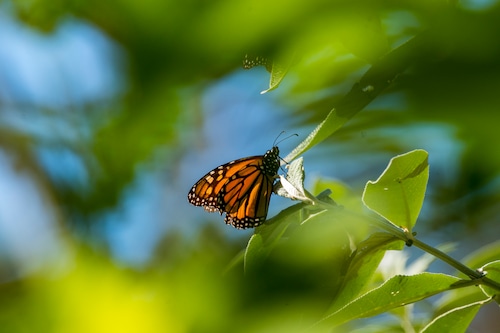By The Associated Press’s Todd Richmond
MADISON, WIS. (AP) As pesticides, habitat loss, and climate change continue to harm the cherished pollinator, the number of monarch butterflies spending the winter in the western United States has fallen to its second-lowest level in almost thirty years.
Here’s what you should know:
The survey began in 1997
North America is home to monarch butterflies, which are distinguished by their characteristic orange and black wings. The World Wildlife Fund, which has not yet released data for this year, counts monarchs in the eastern United States that spend the winter in Mexico. The California coast is usually where monarchs that live west of the Rocky Mountains spend the winter.
For the past 28 years, the Xerces Society for Invertebrate Conservation has been monitoring western overwinter populations in interior California and Arizona, as well as along the California coast and northern Baja California. In 1997, the greatest number ever reported was 1.2 million. The group said on Friday that it only counted 9,119 monarchs in 2024, a 96% drop from 2023’s total of 233,394. Since the survey’s inception in 1997, the total was the second-lowest. In 2020, 1,901 monarchs set a record low.
According to the survey, only 198 butterflies were found this year in a Santa Barbara location managed by The Nature Conservancy that saw 33,200 monarchs the previous winter.
Heat may have doomed western monarchs
The primary threat to monarchs throughout the continent is the disappearance of milkweed, which serves as the host plant for the larvae of the insects. According to Monarch Joint Venture, an organization that seeks to safeguard monarchs, the plant has been going extinct due to a mixture of drought, wildfires, agriculture, and urbanization. The Xerces Society claims that many of the remaining plants are tainted by pesticides.
According to Emma Pelton, an endangered species scientist with the Xerces Society, it’s unknown what led to such a drastic decline in the western population in a single year. According to her, reproduction may have been hampered by last year’s triple-digit temperatures in the western states, and the monarch population is already modest.
According to Pelton, monarchs suffer when the temperature reaches 100 degrees Fahrenheit, and they are killed by temperatures higher than 108. In July, a heat wave swept through western states, pushing temperatures well beyond 100 degrees in some places. For instance, on July 5, Palm Springs reached a record 124. In early October, northern California had yet another heat wave that broke heat records in several locations.
FILE: On September 12, 2023, Canadian monarch butterflies pause in Cleveland to rest before continuing on to Mexico. (File: Sue Ogrocki/AP Photo)AP
Western monarchs future looks murky
According to Pelton, it is too soon to predict the long-term effects of the severe losses on the population of western monarchs as a whole. According to Pelton, insects do have the capacity for exponential growth. The number of butterflies increased by almost 13,000% to 247,246 the next year after plummeting to 1,901 in 2020. 335,479 monarchs were counted in the study the following year.
Pelton described the population decline in 2024 as negative news. However, we’ve witnessed amazing healing. This does not preclude the existence of Western rulers. Hopefully, it serves as a reminder that a poor year can cause them to regress considerably.
Federal officials working on protections
In December 2024, the U.S. Fish and Wildlife Service declared that it was attempting to list monarchs as threatened. This would make it illegal for anyone to kill, transport, or alter their property in a way that would make it permanently unusable for the species, such as removing all milkweed from the land. Additionally, 4,395 acres in seven coastal California counties that are used as western monarch overwintering grounds would be protected by the listing.
The idea will be subject to a public feedback process ending in March. If officials choose to proceed, the agency has until December to formally label the monarch as threatened.
In December 2024, the environmental law firm Earthjustice petitioned the EPA to require testing of chemical effects on insects like butterflies, moths, and bees.

